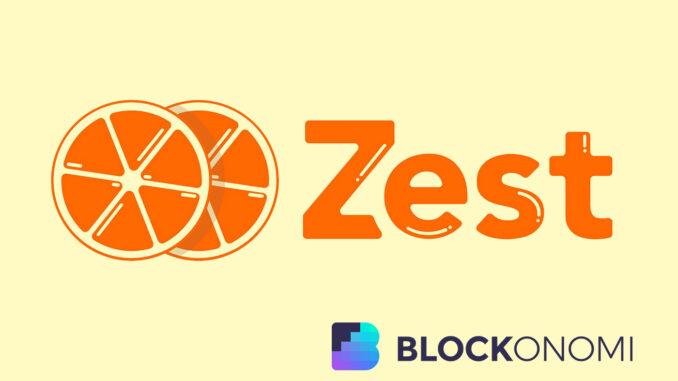
[ad_1]
Zest Protocol is here to provide access to sustainable Bitcoin yield, for liquidity providers, through its lending pools.
An on-chain Bitcoin capital market for institutional borrowers, Zest allows opportunities for on-chain financing, without the constant threat of liquidation.
Bitcoin is not a passive asset, it needs productive action from its community to unlock its potential and gain value. For a long time, it wasn’t easy to earn a passive income with Bitcoin.
Now, there are a lot more tools entering the marketplace.
That’s exactly what the blockchain´s change of paradigm is about; taking the power away from the big players, and giving it to the masses.
Zest Makes Earning With Bitcoin Easier
A decentralized club of delegates manages the Zest pools, whitelisting borrowers, and earning performance fees.
The mission?
To strengthen, and help build a more solid Bitcoin economy. The goal?
To reach a $120 Trillion market.
Bitcoin sitting in a wallet is completely unproductive. Zest is changing all that.
A little history:
The Bretton Woods Treaty, created right after the WWll, based the world’s economy on gold.
And that was alright. Gold was the basis for value, and for a while it worked.
But now the times have changed, and the possibilities of creative earning are blooming everywhere.
🍊 Meet Zest Protocol 🍊
Zest is on-chain Bitcoin capital markets. Undercollateralised bitcoin liquidity for institutional borrowers, zesty yields for individual Bitcoin lenders.
We’re bringing the $120 trillion bond market on-chain. Zesty.🍊
— tycho.btc 🍊 (@TychoOnnasch) February 17, 2022
Making Passive Income With Bitcoin
Turning a passive Bitcoin into a productive Bitcoin takes a few steps.
Centralized yield products, like Celcius or BlockFi, are awesome indeed. But not everyone can have clean access to them, because of regulatory requirements.
Wrapped BTC yield opportunities from other L1s, on the other hand, add new trust assumptions by verifying, wrapping and unwrapping on their platforms.
And they aren´t decentralized.
Zest is probably offering the most secure decentralized network in the world. And you wouldn’t want to miss that.
The Zest Ecosystem
Liquidity providers, pool delegates, borrowers and stakers are all working together in the Zest ecosystem.
Here is how it works:
Liquidity Providers are the everyday users, who deposit Bitcoin into a liquidity pool. They expect to fund loans and earn yield (now, APYs are roughly about 3-5% for unsecured Bitcoin).
Pool Delegates are responsible for managing those liquidity pools. Pool delegates seek for agreements with borrowers off-chain, and perform diligence.
After studying and authorizing a borrower, they include them in a pool, so that liquidity providers can consider fulfilling their loan applications. A pool delegate gets a reward too, by sharing in the interest payments.
Borrowers are the applicants for capital from the liquidity providers, once they are boarded on a pool, by their pool delegate.
They have to create a vault, and provide a Bitcoin address to receive funds. The vault can hold collateral deposits, if the pool delegate finds it necessary to require it.
Stakers Each liquidity pool has a parallel staking pool attached to it, as a form of security measure. That is, in case any of the borrowers defaults.
Pool delegates are stakers in their own pools, but anyone can participate by staking along with the pool delegate, to make higher profits.
The Protocol Treasury Here the Bitcoin revenues hoard in native BTC, and it acts as a backup plan in case of an unexpected shortfall event.
And last but not least, we have the Zest token holders, who have the voting privilege on general updates to the protocol, and on on-boarding pool delegates.
Zest tokens are minted proportionally to the Bitcoin input in the Protocol Treasury.
An important thing for the token holders is the fact that the higher the Zest token trades against Bitcoin, the lower its issuance.
All of this creates a free market for credit assessment. Anyone who has an edge in assessing someone’s credit can become a pool delegate.
A Well Thought Out System
Clearly, the first pool delegates will lend to institutional borrowers they trust, based on mutual knowledge.
But this precaution can evolve, based on borrowers’ on-chain data. Improving the pool delegates´ skills to gather the good borrowers.
Sharpening your instinct is a healthy brain exercise as well. There are no limits, participation is open, and the revenues could reach high.
Stacks Network
Borrowers and liquidity providers can participate with just a Bitcoin wallet address. Whereas stakers and pool delegates have to work with the Stacks platform.
Zest uses Clarity Smart Contracts on the Stacks network.
These Clarity smart contracts have the capacity to trigger the Zest protocol, and liquidate collateral or staked funds, in case of borrowers´ payment delays.
Furthermore, Zest uses Taproot-enabled Discrete Log Contracts (DLCs) in order to make the guarantee deposits of BTCs in pools, more transparent and trustable.
Speaking of trust; the four mainstays trust assumptions a Zest´s user makes are
1. Trust on the Bitcoin blockchain.
2. Trust that the Stacks´ Clarity smart contracts are capable of reading and analyzing the liquidity pools, the staking pools, and the collateral funds correctly, and make the right decisions to cover any mishapps.
3. Trust on Zest protocol´s audited Smart contract.
4. Trust on the pool delegate the user chose, based on their performance. Pool delegate´s on-line activity (yields, previous loans, defaults etc.), is fully accessible to users, encouraging a sound competition among them.
The global bond market today, (where governments, universities, institutions and public corporations borrow capital from private investors), is worth about $120 Trillion.
It’s no secret that this humongous budget is already moving to Bitcoin. Zest is ready and in the pole-position, to play the upper hand in this paradigm shift.
The company is also planning to issue tokenized loan receipts to lenders. This way, the created fixed-income Bitcoin bonds, will be tradeable on secondary markets.
Zest issued Bitcoin bonds can be traded in many ways.
On-chain capital markets will democratize capital accessibility. Anyone with an edge in assessing credit can become a pool delegate, and put profit hungry borrowers together.
For instance, anyone who could assess the credit worthiness of their suppliers, could apply to become a pool delegate.
Now, through Zest´s Stack Clarity Smart Contracts, the suppliers can access Bitcoin credit funds. The pool delegate and the providers will get their rewards too.
Bottomline – everybody wins. Adam Smith´s dreams are finally coming true!
Loads of Potential
At first, Zest will provide loans to OTC (over the counter) desks, exchanges, market makers and arbitraje traders. The largest Bitcoin borrowers today.
This is not abstract theory. Genesis generated some $13 Billion in Bitcoin loans, only in Q4 2021.
Maple Finance, pioneered for lending undercollateralized USDC on Ethereum, issuing some U$ 610 Million, only just in their first eight months on main-net.
Zest is hard at work today, to have their testnet launch ready by the end of Q1 2022. Right after multiple audits and stress tests, they´re planning to be ready for full launch by Q2 2022.
Changes are happening fast, and technological revolutions are growing stronger. With more ways to earn – cryptos will become more popular – especially with institutional investors.
The new tools are giving the power back to the common people, and on-chain capital markets will definitely do their share, to democratize access to capital and finances.
There will always be opportunities for income generation with passive assets. While passive earnings with Bitcoin were slower to come around than other platforms – Zest is making it happen.
The input that Stacks´ Clarity Smart Contracts add to Zest, will increase security and profitability to the experience. You wouldn’t want to miss this one!
[ad_2]
Source link






 Bitcoin
Bitcoin  Ethereum
Ethereum  Tether
Tether  XRP
XRP  Solana
Solana  USDC
USDC  Dogecoin
Dogecoin  Cardano
Cardano  TRON
TRON
Be the first to comment